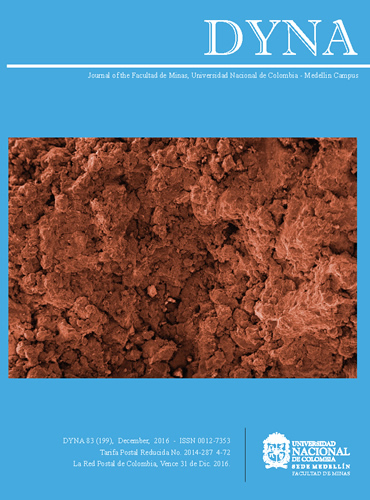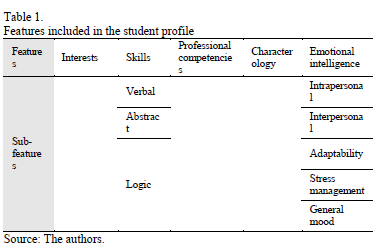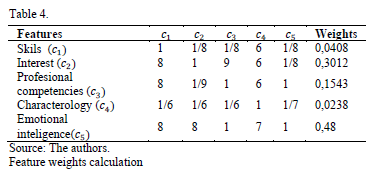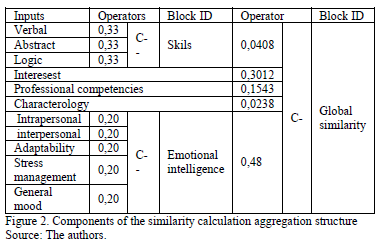A college degree recommendation model
Modelo de recomendación de carreras univeristarias
DOI:
https://doi.org/10.15446/dyna.v83n199.54360Palabras clave:
recommender systems, college degree recommendation, AHP, student profile (en)sistemas de recomendación, recomendación de carreras universitarias, AHP, perfil del estudiante (es)
Descargas
DOI: https://doi.org/10.15446/dyna.v83n199.54360
A college degree recommendation model
Modelo de recomendación de carreras univeristarias
Milton Rafael Maridueña-Arroyave a & Ailyn Febles-Estrada b
a Universidad de Guayaquil, Guayaquil, Guayas, Ecuador, milton.mariduenaa@ug.edu.ec
b Universidad de las Ciencias Informáticas, Habana, Cuba. ailyn@uci.cu
Received: November 25th, de 2015. Received in revised form: May 20th, 2016. Accepted: June 2nd, 2016
This work is licensed under a Creative Commons Attribution-NonCommercial-NoDerivatives 4.0 International License.
Abstract
Selecting
a profession suitable to students' expectations implies taking into account
multiple factors. Despite its usefulness and high impact, there are
shortcomings in current university major recommendation models. Among these
limitations are the lack of flexible models, the dependence on historical
information and the inadequate weighting of the factors involved. In this
paper, a new college degree recommendation model based on psychological student
profiling and the analytical hierarchical process is presented. It includes
database construction, student profiling, college degree information filtering
and recommendation generation. Its implementation made it possible to improve
reliability in the recommendation process of college degree. A case study is
shown to demonstrate the model applicability.
Keywords: recommender systems, college degree recommendation, AHP, student profile.
Resumen
Con vistas a
la elección de una profesión futura que resulte adecuada a las expectativas de
una persona es necesario tomar en cuenta múltiples factores. A pesar de su
potencial impacto persisten insuficiencias en el tratamiento del proceso de
recomendación de las carreras universitarias. Entre ellas se destacan la falta
de modelos flexibles no dependientes de datos históricos, y la correcta
ponderación de los distintos factores que intervienen en la elección de la
carrera. En el presente trabajo se propone un modelo para la recomendación de
carreras universitarias basado en el perfilado psicológico del estudiante y en
el proceso de jerarquía analítica. Su implementación posibilita mejorar la
fiabilidad de las recomendaciones de carreras universitarias. Se desarrolla un
estudio de caso real con especial énfasis en carreras relacionadas con las
ciencias de la salud y de la información con el propósito de demostrar la
aplicabilidad del modelo.
Palabras clave: sistemas de recomendación, recomendación de carreras universitarias, AHP, perfil del estudiante
1. Introduction
Selecting a future career is a complex decision process involving preferences, aptitudes, interests and qualities. Current process based solely on multicriteria decision models allows to handle only a limited number of options (college degrees) [1]. Recommendation models are more adequate due to the relative easiness to take into account users profiles and expectations [2]. Despite the high impact and usefulness of recommending a college degree, there is a group of limitations such as:
- Current models are based mainly on collaborative filtering [3-5] or data mining, like association rules and decision trees [6-8], nevertheless very frequently, there is a lack of historical information making impossible to use these approaches. For example when dealing with new students, they do not have information about them, and they are then unable to generate recommendations.
- Another shortcoming is that current approaches are based solely on specific subject recommendation, not on whole college degrees.
- Similarity calculation is based in weighted averaging of features. This operator does not take into account interaction like compensation, orness and bipolarity [9-11].
- Models lack dealing with the psychological profile of students [12] to reach a more reliable recommendation .
- In this paper a new model of college degree recommendation is presented using a flexible similarity calculation based on weights obtained from the analytic hierarchy process (AHP), a hierarchical aggregation process using the weighted power mean [13] and the student's psychological profiling.
The outline of this paper is as follows: Section II is dedicated to recommendation models, Section III to AHP. The proposed framework is presented in Section IV. A case study is discussed in Section V. The paper closes with concluding remarks, and the discussion of future work in Section VI.
2. Recommendation models
Recommendation systems are useful in decision making process providing the user with a group of options hoping to meet expectations [2]. Based on the information they use and the algorithms used to generate the recommendations, we can distinguish the following techniques [14, 15]:
- Collaborative Filtering Recommender Systems: they use users' ratings to recommend items to a specific user. They aggregate preferences of the other users' preferences to generate new recommendations.
- Content-based Recommender Systems: They learn a user profile based on the features of the items that the user had liked. The user profile could be completed based on psychologic user profiling techniques.
- Knowledge Based Recommender Systems: these systems use the knowledge about users' necessities to infer recommendations. They use cased based reasoning techniques frequently.
- Utility Based Recommender Systems: they make recommendations by computing a utility value.
In the specific case of the systems for vocational guidance, existing proposals rely fundamentally on collaborative filtering approaches [3-5] or data mining techniques [6-8]. But often there is not historical information which makes it impossible to adopt these approaches. Within these systems the Degree Compass System of Austin Peay State University [16] stands out. However, this system shares a common limitation with the rest of the systems studied related to focusing only in the recommendation of specific courses rather than college degrees entirely.
It is possible to improve the reliability of the recommendations obtaining a student profile based on their psychological traits [17]. This profile allows developing recommendations based on content given the similarity of shared characteristics between the object to be recommended and the student profile [12].
3. Analytic Hierarchy Process
The Analytic Hierarchy Process is a technique created by Tom Saaty [18] for making complex decision based on mathematics and psychology. The steps for implementing the AHP proposed model are:
- Decompose the problem into a hierarchy of goal, criteria, sub-criteria and alternatives.
- Collect data from experts or decision-makers corresponding to the hierarchic structure, in the pairwise comparison of alternatives on a qualitative scale.
- Assign a weight to criteria and sub-criteria.
- Calculate the score for each of the alternatives through pairwise comparison.
AHP can be used in addition to the group assessment [19]. In this case to obtain the final value, the weighted geometric mean [20] is used. The weighting could give different weights to the criteria of the specialists taking into account various factors such as authority, expertise, effort, etc.
The integration of AHP model with university degrees recommendation allows to assign a weight to each of the factors involved in the suggestion of a college career, doing this more in line with reality and therefore more reliable.
4. Proposed framework
The proposed framework is presented in Fig. 1. It is based mainly on the proposal made by Cordon [15] for recommendation systems based on content/knowledge adapted to the characteristics of the application domain and allowing flexibility in the aggregation of the similarity of the characteristics in the user profile with respect to ideal profiles of the college degree.
4.1. Database creation
A key for a recommendation model is the
creation of the database. Each university degree  will be described by a set
of characteristics that make up the profile:
will be described by a set
of characteristics that make up the profile:

Each of the features which are reflected in the psychological profile may be composed of sub-features.
Each university degree will be described by a vector of features:

There are techniques for generating these profiles automatically or semi-automatically for recommendation systems based on psychological profiles [21]. In this case, an expert or group of experts is suggested.
Having described the university degrees in this set:

Then, it is stored in a database.
4.2. Acquisition of the user profile
The proposed framework presents a fundamental difference with previous proposals, it is focused in the fact that most of this information may be collected by psychological tests and can be supplied by psychologists to advise the student.
The student profile corresponds to his psychological profile. In this activity, this information is stored in the database.

This profile will be composed of a set of attributes:

Features such as skills and emotional intelligence are included.
4.3. College degree filtering
In this activity, college degrees according to the similarity with the user profile are filtered to find out which are the most appropriate for the student.
The similarity between user profile,  , and each ideal college degree profile
, and each ideal college degree profile  is calculated. For the calculation of the overall similarity a
hierarchical aggregation is used taking into account the following factors:
is calculated. For the calculation of the overall similarity a
hierarchical aggregation is used taking into account the following factors:
- Degree of simultaneity.
- Relative importance of the inputs (weights).
Aggregation function [22]:  is obtained by a process of hierarchical
aggregation. The weighted mean power, (WPM) as in the Logic Scoring of
Preference (LSP) method [22] is used. The rth average power is defined as follows:
is obtained by a process of hierarchical
aggregation. The weighted mean power, (WPM) as in the Logic Scoring of
Preference (LSP) method [22] is used. The rth average power is defined as follows:

where  y
y  and r can be selected to
achieve desired logical properties. For determining each feature and
sub-features weights AHP method [18] is used.
and r can be selected to
achieve desired logical properties. For determining each feature and
sub-features weights AHP method [18] is used.
4.4. Recommendation
For the calculation of the similarity measures the following expression is used:

Where

is a vector containing the similarity of
all user profile attributes regarding the description of the college degree  .
.
The similarity measure can be obtained
from a distance measurement, if  then[23] :
then[23] :

In case of ordered lists, such as characterology, interest and professional competencies, Kendal Tau distance is used [24, 25].
4.5. Recommending
In this activity, a set of college degrees that match with the students profiles is suggested. After calculating the similarity between the student profile and each college degree profile in the database each college degree is ordered and is represented with the following similarity vector:

The best are those that best meet the needs of the student profile (greater similarity).
5. Case study
To show the applicability of the model, a case study at the University of Guayaquil is developed. College degree ideal profiles was acquired from experts taking into account features and sub-features as it is shown in Table 1.
Ideal college degree profiles are obtained in a group of college degree in Health and Information Sciences (Table 2). They are composed by numerical scores (skills, emotional intelligence) and ordered lists (interests, professional competencies, characterology) information.
In the case of interest A, B, C, E, F, G, I, L and N correspond to Science Professionals (health areas), Technology sub-professional (engineering areas), Consumer Economics (business), Job Office (commerce and secretarial), Professional Art (design, general arts), Professional Social Service (related to providing services and care areas), sub-professional technologies (technologies, technical), Communication (use of language as part of the job) and Social Service sub-professionals (personal care) respectively.
In the case of professional skills A, B, D, F, I, M and O correspond to Politics and Law (jurisprudence), Biomedical (medical sciences), Education (educational sciences), Biotechnology (chemical sciences) Oral health (dentistry), Communication and Service (media) and Psychosocial Health (psychology) respectively.
Later, the psychologist obtained a student profile which is shown in Table 3, based on observation and psychological tests.
Using the AHP method the following weights structure (Table 4) was obtained. These are translated into weight vector associated with the features V = (0.0408, 0.3012, 0.1543, 0.0238, 0.48). In this case, equal weight to the sub-attributes are set.
Then, the aggregation structure is obtained (Fig. 2). Aggregation operators that reflect simultaneity as established LSP [26, 27] were used.
These operators reflect specific requirements and logic conditions, such as simultaneity and replaceability.
Then, the aggregation structure is obtained (Fig. 2). Aggregation operators that reflect simultaneity as established LSP [26, 27] were used.
These operators reflect specific requirements and logic conditions, such as simultaneity and replaceability.
The similarity of the ideal profile to different college degrees gives the following result.
In the phase of recommendation, those college degrees that come closest to student profile will be recommended. An ordering based on this comparison is:

If the system recommend the three college degrees more similar to the student profile, they would be the following: Odontology, Nursery and Obstetrics; which coincide with the actual recommendations given by the department of student welfare.
6. Conclusions
Despite the impact along life of deciding what career to pursue, shortcomings persist in treating recommendation process of college degrees. This paper presents a model for recommendation of college degrees following the content-based approach. It is based on the psychological student profiling and the database of ideal college degree profiles.
The AHP method allows a correct weighting of different factors involved. Additionally, the LSP method of aggregation operators permits to reflect simultaneity and replaceability in the process. The previous elements and the inclusion of the psychological profiling of students allows to reach a more reliable recommendation.
Future work will be related to the inclusion of context information in the model creation of the database from multiple experts, as well as obtaining the weights of the features using group assessments. Other areas of future work will be related to the management of heterogeneous information and the development of a software tool.
References
[1] Rana, S., Dey, P.K. and Ghosh, D., Best engineering college selection through fuzzy multi-criteria decision making approach: a case study. UNIASCIT Journal, 2(2), pp. 246-256. 2012.
[2] Leiva, J.L., et al., Realidad aumentada y sistemas de recomendación grupales: Una nueva perspectiva en sistemas de destinos turísticos. Estudios y perspectivas en turismo, 23(1), pp. 40-59. 2014.
[3] Castellano, E.J. and Martínez-Orieb, L., A Crs for academic orientation using qualitative assessments. in e-Learning, 2008.
[4] Castellano, E.J., Martínez, L. y Barranco, M., Recomendación de perfiles académicos mediante algoritmos colaborativos basados en el expediente. in IADIS Ibero-Americana, 2007.
[5] Denley, T., Degree compass: A course recommendation system. Educause Review Online, 2013.
[6] Bendakir, N. and Aïmeur, E., Using association rules for course recommendation. in Proceedings of the AAAI Workshop on Educational Data Mining. 2006.
[7] Lin, C.F., et al., Data mining for providing a personalized learning path in creativity: An application of decision trees. Computers & Education, 68, pp. 199-210. 2013. DOI: 10.1016/J.COMPEDU.2013.05.009
[8] Whitten, L. and Sanders, A., Data-mining and predicting academic success: A recommendation system for college students. Educational Technology, 53(4), pp. 40-42, 2013.
[9] Wang, X. and Yeung, D., Using fuzzy integral to modeling case based reasoning with feature interaction. in Systems, Man, and Cybernetics, 2000 IEEE International Conference on. IEEE. 2000. DOI: 10.1109/ICSMC.2000.886578
[10] Yager, R.R., Soft aggregation methods in case based reasoning. Applied Intelligence, 21(3), pp. 277-288. 2004. DOI: 10.1023/B:APIN.0000043560.57137.20
[11] Beliakov, G., Calvo, T. and James, S., Aggregation of preferences in recommender systems, in Recommender systems handbook Springer. pp. 705-734. 2011. DOI: 10.1007/978-0-387-85820-3_22
[12] Carrillo, G. y Ochoa, X., Recomendación de objetos de aprendizaje basada en el perfil del usuario y la información de atención contextualizada, en: LACLO 2013-Octava Conferencia Latinoamericana de Objetos y Tecnologías de Aprendizaje. 2013.
[13] Hatch, K., Dragićević, S. and Dujmović, J., Logic scoring of preference and spatial multicriteria evaluation for urban residential land use analysis, in Geographic Information Science. Springer. pp. 64-80. 2014. DOI: 10.1007/978-3-319-11593-1_5
[14] Jannach, D., Tutorial: Recommender systems, in International Joint Conference on Artificial Intelligence Beijing, August 4, 2013.
[15] Cordón, L.G.P., Modelos de recomendación con falta de información. Aplicaciones al sector turístico., Universidad de Jaén. 2008
[16] Denley, T., Austin Peay State University: Degree Compass. Educause Review [Online]. Available at: http://www.educause. edu/ero/article/austin-peay-state-university-degree-compass, 2012.
[17] Nunes, M.A.S.N. and Cerri, S.A., Recommender systems based on human psychological reputation. in Recommenders' 06. com-The Present and Future of Recommender Syste MS. MyStrands. 2006.
[18] Saaty, T.L., What is the analytic hierarchy process?, in Mathematical models for decision support. Springer. pp. 109-121. 1988. DOI: 10.1007/978-3-642-83555-1_5
[19] Aguarón, J., Escobar, M.T. and Moreno-Jiménez, J.M., The precise consistency consensus matrix in a local AHP-group decision making context. Annals of Operations Research, pp. 1-15. 2014. DOI: 10.1007/s10479-014-1576-8
[20] Xu, Z., On consistency of the weighted geometric mean complex judgement matrix in AHP. European Journal of Operational Research, 126(3), pp. 683-687. 2000. DOI: 10.1016/S0377-2217(99)00082-X
[21] Nunes, M.A.S., Cerri, S.A. and Blanc, N., Towards user psychological profile. in Proceedings of the VIII Brazilian Symposium on Human Factors in Computing Systems. Sociedade Brasileira de Computação. 2008.
[22] Pérez-Teruel, K., Leyva-Vázquez, M. and Estrada-Sentí, V., Mental models consensus process using fuzzy cognitive maps and computing with words. Ingeniería y Universidad, 19, pp. 173-188. 2015. DOI: 10.1007/s10479-014-1576-8
[23] Bonillo, M.L., Razonamiento basado en casos aplicado a problemas de clasificación. Tesis de grado. Universidad de Granada, España, 2003.
[24] Ha, V. and Haddawy, P., Similarity of personal preferences: Theoretical foundations and empirical analysis. Artificial Intelligence, 146(2), pp. 149-173. 2003. DOI: 10.1016/S0004-3702(03)00013-4
[25] Knight, W.R., A computer method for calculating Kendall's tau with ungrouped data. Journal of the American Statistical Association, 61(314), pp. 436-439. 1966. DOI: 10.1080/01621459.1966.10480879
[26] Tapia-Rosero, A., et al., Fusion of preferences from different perspectives in a decision-making context. Information Fusion, 2016.29: pp. 120-131. DOI: 10.1016/J.INFFUS.2015.07.006
[27] Dujmović, J.J. and Nagashima, H., LSP method and its use for evaluation of Java IDEs. International journal of approximate reasoning, 41(1), pp. 3-22. 2006. DOI: 10.1016/J.IJAR.2005.06.006
M.R. Maridueña-Arroyave, es Dr. (Ph.D.) en Ciencias Pedagógicas, Candidato a Dr. (Ph.D.) en Ciencias Informáticas, MSc. en Docencia Universitaria e Investigación Educativa, Candidato a MSc. en Investigación Matemática, Ingeniero en Computación. Profesor con 18 años de experiencia docente universitaria en carreras de Ingeniería en Sistemas Computacionales, Informática y Networking. Actualmente Director de Investigaciones y Proyectos Académicos - DIPA de la Universidad de Guayaquil, Ecuador. ORCID: 0000-0002-8876-1896
A. Febles-Estrada, es Lic. en Ciencias de la Computación de la Universidad de La Habana, Cuba. Dra. en Ciencias Técnicas (Ph.D.) del Instituto Superior Politécnico José Antonio Echeverría. Profesora de la Universidad de las Ciencias Informáticas, La Habana, Cuba. ORCID: 0000-0002-9678-2230
Referencias
Rana, S., Dey, P.K. and Ghosh, D., Best engineering college selection through fuzzy multi-criteria decision making approach: a case study. UNIASCIT Journal, 2(2), pp. 246-256. 2012.
Leiva, J.L., et al., Realidad aumentada y sistemas de recomendación grupales: Una nueva perspectiva en sistemas de destinos turísticos. Estudios y perspectivas en turismo, 23(1), pp. 40-59. 2014.
Castellano, E.J. and Martínez-Orieb, L., A Crs for academic orientation using qualitative assessments. in e-Learning, 2008.
Castellano, E.J., Martínez, L. y Barranco, M., Recomendación de perfiles académicos mediante algoritmos colaborativos basados en el expediente. in IADIS Ibero-Americana, 2007.
Denley, T., Degree compass: A course recommendation system. Educause Review Online, 2013.
Bendakir, N. and Aïmeur, E., Using association rules for course recommendation. in Proceedings of the AAAI Workshop on Educational Data Mining. 2006.
Lin, C.F., et al., Data mining for providing a personalized learning path in creativity: An application of decision trees. Computers &
Education, 68, pp. 199-210. 2013. DOI:10.1016/J.COMPEDU.2013.05.009
Whitten, L. and Sanders, A., Data-mining and predicting academic success: A recommendation system for college students. Educational Technology, 53(4), pp. 40-42, 2013.
Wang, X. and Yeung, D., Using fuzzy integral to modeling case based reasoning with feature interaction. in Systems, Man, and Cybernetics, 2000 IEEE International Conference on. IEEE. 2000. DOI:10.1109/ICSMC.2000.886578
Yager, R.R., Soft aggregation methods in case based reasoning. Applied Intelligence, 21(3), pp. 277-288. 2004. DOI:10.1023/B:APIN.0000043560.57137.20
Beliakov, G., Calvo, T. and James, S., Aggregation of preferences in recommender systems, in Recommender systems handbook Springer. pp. 705-734. 2011. DOI:10.1007/978-0-387-85820-3_22
Carrillo, G. y Ochoa, X., Recomendación de objetos de aprendizaje basada en el perfil del usuario y la información de atención contextualizada, en: LACLO 2013-Octava Conferencia Latinoamericana de Objetos y Tecnologías de Aprendizaje. 2013.
Hatch, K., Dragićević, S. and Dujmović, J., Logic scoring of preference and spatial multicriteria evaluation for urban residential land use analysis, in Geographic Information Science. Springer. pp. 64-80. 2014. DOI:10.1007/978-3-319-11593-1_5
Jannach, D., Tutorial: Recommender systems, in International Joint Conference on Artificial Intelligence Beijing, August 4, 2013.
Cordón, L.G.P., Modelos de recomendación con falta de información. Aplicaciones al sector turístico., Universidad de Jaén. 2008
Denley, T., Austin Peay State University: Degree Compass. Educause Review [Online]. Available at: http://www. educause. edu/ero/article/austin-peay-state-university-degree-compass, 2012.
Nunes, M.A.S.N. and Cerri, S.A., Recommender systems based on human psychological reputation. in Recommenders' 06. com-The Present and Future of Recommender Syste MS. MyStrands. 2006.
Saaty, T.L., What is the analytic hierarchy process?, in Mathematical models for decision support. Springer. pp. 109-121. 1988. DOI:10.1007/978-3-642-83555-1_5
Aguarón, J., Escobar, M.T. and Moreno-Jiménez, J.M., The precise consistency consensus matrix in a local AHP-group decision making context. Annals of Operations Research, pp. 1-15. 2014. DOI:10.1007/s10479-014-1576-8
Xu, Z., On consistency of the weighted geometric mean complex judgement matrix in AHP. European Journal of Operational Research, 126(3), pp. 683-687. 2000. DOI:10.1016/S0377-2217(99)00082-X
Nunes, M.A.S., Cerri, S.A. and Blanc, N., Towards user psychological profile. in Proceedings of the VIII Brazilian Symposium on Human Factors in Computing Systems. Sociedade Brasileira de Computação. 2008.
Pérez-Teruel, K., Leyva-Vázquez, M. and Estrada-Sentí, V., Mental models consensus process using fuzzy cognitive maps and computing with words. Ingeniería y Universidad, 19, pp. 173-188. 2015. DOI:10.1007/s10479-014-1576-8
Bonillo, M.L., Razonamiento basado en casos aplicado a problemas de clasificación. Tesis de grado. Universidad de Granada, España, 2003.
Ha, V. and Haddawy, P., Similarity of personal preferences: Theoretical foundations and empirical analysis. Artificial Intelligence, 146(2), pp. 149-173. 2003. DOI:10.1016/S0004-3702(03)00013-4
Knight, W.R., A computer method for calculating Kendall's tau with ungrouped data. Journal of the American Statistical Association, 61(314), pp. 436-439. 1966. DOI:10.1080/01621459.1966.10480879
Tapia-Rosero, A., et al., Fusion of preferences from different perspectives in a decision-making context. Information Fusion, 2016.29: pp. 120–131. DOI:10.1016/J.INFFUS.2015.07.006
Dujmović, J.J. and Nagashima, H., LSP method and its use for evaluation of Java IDEs. International journal of approximate reasoning, 41(1), pp. 3-22. 2006. DOI:10.1016/J.IJAR.2005.06.006
Cómo citar
IEEE
ACM
ACS
APA
ABNT
Chicago
Harvard
MLA
Turabian
Vancouver
Descargar cita
CrossRef Cited-by
1. Yan Meng, Min Fu. (2020). CMRS: Towards Intelligent Recommendation for Choosing College Majors. 2020 4th International Conference on Advances in Image Processing. , p.152. https://doi.org/10.1145/3441250.3441272.
Dimensions
PlumX
Visitas a la página del resumen del artículo
Descargas
Licencia
Derechos de autor 2016 DYNA

Esta obra está bajo una licencia internacional Creative Commons Atribución-NoComercial-SinDerivadas 4.0.
El autor o autores de un artículo aceptado para publicación en cualquiera de las revistas editadas por la facultad de Minas cederán la totalidad de los derechos patrimoniales a la Universidad Nacional de Colombia de manera gratuita, dentro de los cuáles se incluyen: el derecho a editar, publicar, reproducir y distribuir tanto en medios impresos como digitales, además de incluir en artículo en índices internacionales y/o bases de datos, de igual manera, se faculta a la editorial para utilizar las imágenes, tablas y/o cualquier material gráfico presentado en el artículo para el diseño de carátulas o posters de la misma revista.























